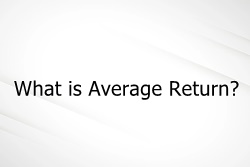What is Moving Average?
Market analysts and investors can use a moving average to assess the direction of a trend.It averages a financial security's data points over a given period by dividing the total by the number of data points. Since it is constantly recalculated using the most recent price data, it is known as a moving average. By monitoring the price fluctuations of an asset, analysts utilize the moving average to look for support and resistance.
A moving average reflects a security's prior price action or movement. Analysts and investors use this knowledge to forecast the asset's price movement. It is regarded as a Lagging Indicator because it produces a signal or shows the direction of a particular trend by trailing the Underlying asset's price movement.
Moving Average Indicator
A moving average indicator is a tool that traders use to determine the likely direction of an asset's price by looking at its recent price movement. This indicator is used to calculate the price Volatility concerning the average price.
To form a trend tracking indicator, moving averages smooth the price data. They identify the present direction rather than foretell it, yet they lag since they are dependent on historical prices.
Types of Moving Average
Traders in the stock market employ two different types of moving averages. These are as follows:
Simple Moving Average (SMA)
The most basic moving average is calculated by multiplying the most recent data points by the number of periods. An SMA is a lagging indicator since it is calculated for several prices, such as high, low, open, and close and depends on historical price data for a particular time.
Traders use this indicator to determine the buy and sell signals for equities and support and resistance zones. The formula for SMA is as follows:
SMA = (A1+A2+A3…. An)/N
Where,
- (A1, A2, A3….An) represents the closing price of respective days
- N represents the number of days
Talk to our investment specialist
Exponential Moving Average (EMA)
It gives recent pricing points greater weight to be more attentive to current data points. The EMA is more sensitive to recent price fluctuations than the SMA since it assigns equal weight to all price changes in a certain period.
It can be calculated as follow:
- SMA for the given period must be calculated first
- Next, calculate the multiplier for weighting the EMA
- The current EMA is calculated by adding the price, multiplier, and the prior period's EMA value to the period from the beginning EMA to the most recent time.
EMA (Current Time Period) = {Closing Price – EMA (Previous Time Period)} x Multiplier + EMA (Previous Time Period)
Difference Between SMA and EMA
Here are the key differences between SMA and EMA:
Degree of Sensitivity to Price
EMA is more sensitive than the SMA to recent price point changes. As a result, recent price changes are more sensitive to the EMA.
Calculation
Determining the EMA is complicated; most charting software makes following an EMA straightforward for traders. The SMA, on the other hand, gives equal weight to all observations in the data set. It is simple to compute, as it is derived from simply calculating the arithmetic mean of prices during the specified time period.
Moving Average Chart
Technical analysts use a moving average chart to examine security price changes. The moving average is generally placed onto a Candlestick or Bar chart and depicts average prices over a given period of time. The price data for each time period is represented by bars or candlesticks.
Moving Average Forecasting
For forecasting long-term trends, the moving average is particularly effective. It can be calculated for any time period. For instance, if you have sales data for twenty years, you can calculate a five-year moving average, a four-year moving average, a three-year moving average, and so on. A 50- or 200-day moving average is frequently used by stock market analysts to spot trends in the market and estimate where the stocks are heading.
Takeaway
As it is a lagging indicator, the moving average is primarily employed to determine the trend of any financial security rather than to provide trading indications. Like other technical indicators, moving averages can be used with other technical instruments, such as price action or momentum indicators.
All efforts have been made to ensure the information provided here is accurate. However, no guarantees are made regarding correctness of data. Please verify with scheme information document before making any investment.












